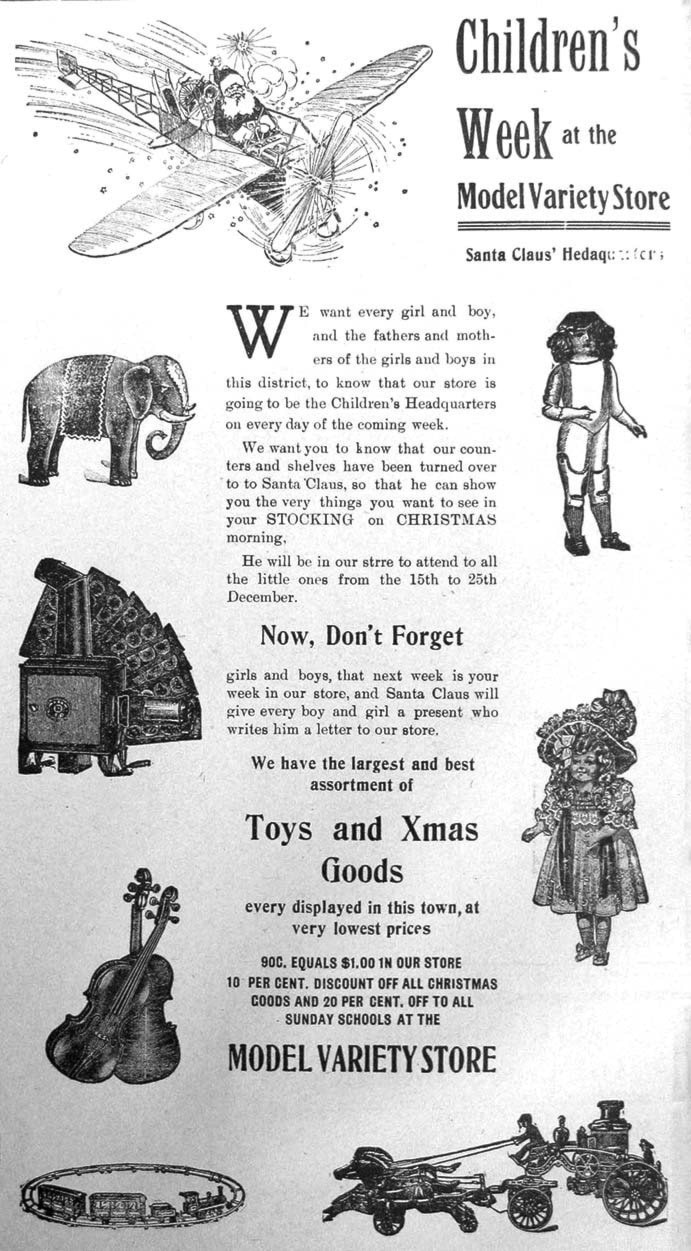Jim Cameron
Christmas, 1913. One hundred Cranbrook Christmases have passed since then. Still, on a quiet winter's evening it is possible to walk the streets of old Cranbrook and imagine how things were a century ago (just a short mental walk, mind you, in case you're busy watching TV rather than reading this). Things remain: people are born (159 that year), people die (54 of them in 1913, including at least two children who died that December, the infant death rate being significantly higher in those days), and 61 couples (half male, half female) married.
It was an age of electricity and automobiles, of telephones (650 customers) and movies, all on a smaller scale of course. But then, Cranbrook was a smaller town.
As far as marriages and funerals and such go, the Anglican Church of Burwell (13th) Avenue is the only church remaining of the original five situated along Louis (1st) Street in 1913. Numerous empty lots between the church and the business district were yet to be filled ("A nice gift for the wife," suggested a local real estate firm). Rotary Park was there (more or less). Actually less, since much of the park was taken up by the city arena which opened for the season during the first week of December. The weather was mild but the ice set up nicely and the curlers, hockey players and skaters soon filled the big old barn while the city orchestra provided the tunes.
Basketball was popular. The new Young Men's Club on the corner of Louis Street and Hanson (8th) Avenue saw numerous games that month. It's a parking lot now but it was a hub of sporting activity at the time. Even the ladies (in a preview of emancipation soon to come) played the occasional game, much to the bemusement of the men.
That Christmas no-one in Cranbrook suspected the world-wide war that would begin the following August. It was the last Cranbrook Christmas for a number of boys whose names now grace the cenotaph.
Chinatown on Durick (7th) Avenue was a hive of activity (illicit and otherwise), as was the (soon to be closed) adjoining red-light district (not a reference to Christmas decorations). Cranbrook's southern boundary ended at Kains (3rd) Street in those days, although there was talk of expansion to the south and north and even over to Slaterville. In general, however, the residential area from Watts (3rd) to Pooley (16th) Avenue (although more crowded today) still carries many echoes of 1913.
The lumber industry was going through some tough times. The "time-cheque" method of payment (in which lumbermen received their salary as late as six months after the job) was a serious bone of contention. It was therefore a tough Christmas for some (nothing new there). All the lumber mills in town are gone now; the only modern-day connection being that of the Leask & Slater mill which became the Sash and Door which became Crestbrook which became Tembec which is now Canfor.
There are still a few hotels remaining that served travelers a century ago: the Cranbrook, the Byng, the York and the Cosmopolitan (standing but vacant). F.J. Spaulding (claiming to be the first motorist to make the trip inland from the coast) had recently praised our local highways. The highways may have been fine but the city roads were not. They were very rough although the city was hesitant to grade them for fear of removing groundcover necessary in keeping the water mains from freezing. (They froze anyway.) The water mains themselves were decidedly not well: generally defective (369 leaks repaired that year) and installed with very few connecting valves, often causing a shutdown of the entire city when a new customer came on line. The entire town was fed from a single eight-inch main which itself was too small. The city council under Mayor Bowness (whose house still stands) decided it wasn't worth repairing the roads until the water mains were fixed (there wasn't enough money anyway). That, coupled with the new "Rule of the Road" (which required all B.C. motorists drive on the right hand side) made travelling a chore.
It you were wandering about town in December 1913, deer were not a problem, probably because of the coyotes also frequently wandering about town (despite the $3.00 provincial bounty).
For those folks wishing to get away for a holiday, the CPR offered return excursions to all points east for under $100 and a trip south to Los Angeles from Spokane for $109 (over $2,000 by today's standards).
St. Mary's Catholic School (later Tenth Avenue School and now Foursquare Church) built by local contractor George Leask, was nearing completion on the edge of town. It's still there although significantly altered in appearance. So too, are the Masonic Lodge (The Studio), the Manual Training Centre and Central School are still standing, all centres of present day community life.
The original post office clock, newly installed in October 1913, (now located in the clock tower in the downtown square of the same name) is now 100 years old. In December 1913, Raworth Jewelers (now the site of Delamont E H Jeweler Ltd.) added two extra striking levers allowing the clock chime to be heard throughout the city. And that, (dear readers) reminds us that not only should we wish both the Tenth Avenue School and the post office clock a happy 100th birthday but that time keeps ticking, ticking, ticking into the future. Have a Happy New Year.
(Thank you to Aunt Mildred for the special Christmas "Jumbo Parentheses Pak" with the lovely hand-knitted carrying pouch.)
